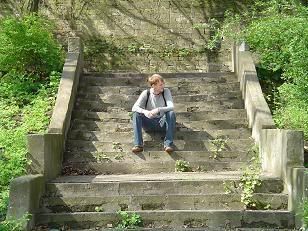The train ride from Moscow to Stavropol was long and,
thanks to the lack of air conditioning, uncomfortable. However, it went as well
as can be expected, and I was lucky to have pleasant neighbors in my
compartment.
It turns out that my apprehensions about finding a decent place to stay and about working in the archives of the city were, although not completely ungrounded, quickly put to rest. I’ve found a modest hostel-style hotel, located about fifteen minutes walk from the further of two archives. This archive as I was afraid, had been undergoing remodeling, but when I arrived last Wednesday, they were open and I’ve had no problems at all. I’m optimistic that a productive few weeks there will be a good way to finish my research here before heading home at the beginning of August.
I don’t, as yet, really know anyone in the city, so what
little free time I have outside working in the archives I’ve devoted to
exploring the city just a little. My first impressions, as I hope the pictures
below will convey, is that it is very green and full of parks and other quiet
spots. It is slightly larger than Vladimir, where I lived before, and seems to
be a little bit better off economically.It turns out that my apprehensions about finding a decent place to stay and about working in the archives of the city were, although not completely ungrounded, quickly put to rest. I’ve found a modest hostel-style hotel, located about fifteen minutes walk from the further of two archives. This archive as I was afraid, had been undergoing remodeling, but when I arrived last Wednesday, they were open and I’ve had no problems at all. I’m optimistic that a productive few weeks there will be a good way to finish my research here before heading home at the beginning of August.
First, the green and the parks:
The city's name, according to the story, comes from the Greek for "city of the cross," even though there is no relation to the Greeks. The story was that a large stone cross was unearthed on the site during the construction of the first fortress in the late 18th century. Thus the city's seal and this statue in one central square. I daresay it is of post-Soviet origin:
Later, when things settled down, the region’s agriculture gained in importance, and the wealthy flocked to the nearby spas and mineral springs.
 |
| Like so many cities, reconstruction of the city's Orthodox cathedral is a major project. |
 |
| Obligatory WWII memorial. The city itself was, in fact occupied by the Germans for about six months during the war. |
 |
| Civil War memorial. |
 |
| View from the old part of the city toward the later Soviet districts. |
 |
| The city's main theater, with a sign proudly announcing the close of the 167th season. That's a pretty long run! |
 |
| A little taste of the parks. And the side of the city administration building. |
It’s the center of a large region, in fact a krai in Russian, rather than oblast’. All that this means, as far as
I can tell, is that there are different subdivisions within the territory,
which include the autonomous region of a national group, rather than just the
regular districts.
In any event, it’s a relatively new city: the official date
is 1777. The city itself sits atop a high point, one of the first foothills of
the Caucasus, at some 600 m above sea level. This made it a good place for a
Cossack outpost, or stanitsa, and
later a major military and administrative center during the period of the
Russian Empire’s expansion further south during the late 18th and
first half of the 19th centuries.
As an
interesting side-effect, many of the Russian language’s early literary names
passed through the city, having been banished to the South from the capital.
Thus the city boasts statues, to mention a few, in honor of Aleksander
Sergeevich, milyi:
 |
| (. . . which is to say, Pushkin. Reference, here.) |
as well as the Romantic poet and playwright Lermontov:
The city's name, according to the story, comes from the Greek for "city of the cross," even though there is no relation to the Greeks. The story was that a large stone cross was unearthed on the site during the construction of the first fortress in the late 18th century. Thus the city's seal and this statue in one central square. I daresay it is of post-Soviet origin:
Later, when things settled down, the region’s agriculture gained in importance, and the wealthy flocked to the nearby spas and mineral springs.
By the Soviet period, the territory was home to an enormous
agricultural sector—the reason why I am here. After WWII, it added gas extraction and
transit between the Caspian basin and the Black Sea to the list of local
sources of wealth and jobs.
Also, there is the obligatory Lenin, standing guard in front
of the territorial parliament, or duma:














































